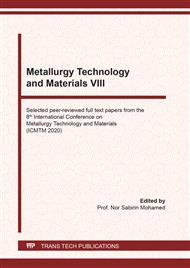[1]
L.I. Chunxu, H.E. Chengdan, X.U. Qijin, JIANG Caiyun, Design of Electrostatic Focusing for Space Electron Beam Welding Gun, Chinese J Aeronaut. 18(3) (2005) 256-262.
DOI: 10.1016/s1000-9361(11)60307-5
Google Scholar
[2]
G. Wang, Z. Chen, J. Li, J. Liu, Q. Wang, R. Yang, Microstructure and mechanical properties of electron beam welded titanium alloy Ti–6246, J Mater Sci Technol. 34 (2018) 570–576.
DOI: 10.1016/j.jmst.2016.10.007
Google Scholar
[3]
P. Mastanaiah, A. Sharma, G.M. Reddy, Process parameters weld bead geometry interactions and their influence on mechanical properties: a case of dissimilar aluminium alloy electron beam welds, Def Technol. 14(2) (2018) 137–150.
DOI: 10.1016/j.dt.2018.01.003
Google Scholar
[4]
A.C. Nunes Jr., M. Fragomeni, The Low Pressure Gas Effects on the Potency of an Electron Beam on Ceramic Fabric Materials for Space Welding, Acta Astronaut. 50(1) (2002) 13-25.
DOI: 10.1016/s0094-5765(01)00143-6
Google Scholar
[5]
M.S. Weglowski, S. Błacha, A. Phillips, Electron beam welding – techniques and trends – review, Vacuum 130 (2016) 72–92.
DOI: 10.1016/j.vacuum.2016.05.004
Google Scholar
[6]
L.M. Lobanov, A.I. Ustinov, V.S. Volkov, A.A. Mokhniuk, V.A. Telichko, S.A. Demchenkov, Al/TiO2 bilayer coatings for space applications: Mechanical and thermoradiation properties, Thin Solid Films 668 (2018) 30–37.
DOI: 10.1016/j.tsf.2018.10.017
Google Scholar
[7]
A.C. Nunes Jr., C. Russell, J. Vaughn, D. O'Dell, B. Bhat, Assessment of corona/arcing hazard for electron beam welding in space shuttle bay at Low Earth Orbit (LEO) for International Space Welding Experiment (ISWE) test results, NASA Technical Memorandum 108525, Marshall Space Flight Center (1996).
Google Scholar
[8]
B.E. Paton (Ed), Space: technologies, materials, structures, Taylor and Francis Inc., New York (NY), (2003).
Google Scholar
[9]
R.M. Poorman, Skylab M551 metals melting experiment, NASA Marshall Space Flight Center, Huntsville (US), NASA-TM-X-64960 (1975).
Google Scholar
[10]
J.M. Fragomeni, A.C. Nunes Jr., A Study of the Effects of Welding Parameters on Electron Beam Welding in the Space Environment, Aerosp Sci Technol. 7(5) (2003) 373-384.
DOI: 10.1016/s1270-9638(03)00031-2
Google Scholar
[11]
B.E. Paton, L.M. Lobanov, Yu.V. Naidich, Yu.V. Zubchenko, E.G. Ternovyi, V.S. Volkov, B.D. Kostyuk, V.P. Umanskii, New electron beam gun for welding in space, Sci Technol Weld Joi. 24(4) (2019) 320–326.
DOI: 10.1080/13621718.2018.1534794
Google Scholar
[12]
K. Liang, C. Yang, Q. Sun, A smeared stiffener based reduced-order modelling method for buckling analysis of isogrid-stiffened cylinder, Appl Math Model. 77(1) (2020) 756-772.
DOI: 10.1016/j.apm.2019.07.061
Google Scholar
[13]
E.P. Fahrenthold, Computational Design of Metal–Fabric Orbital Debris Shielding. J Spacecraft Rockets 54(5) (2017) 1060–1067.
DOI: 10.2514/1.a33736
Google Scholar


